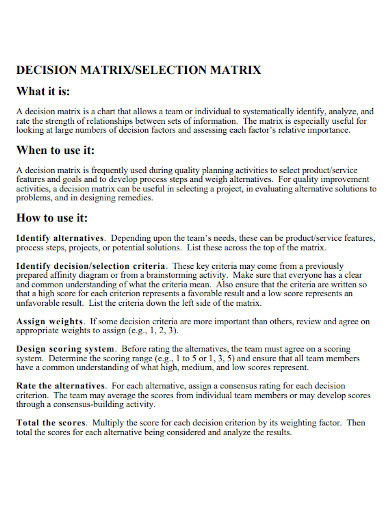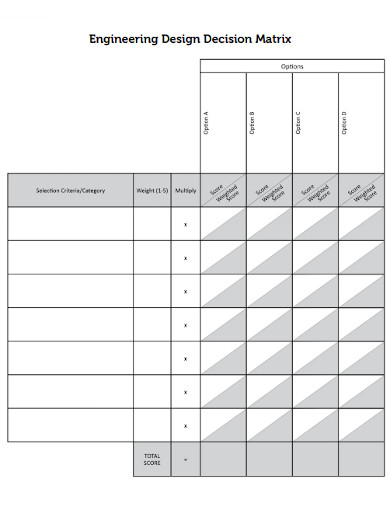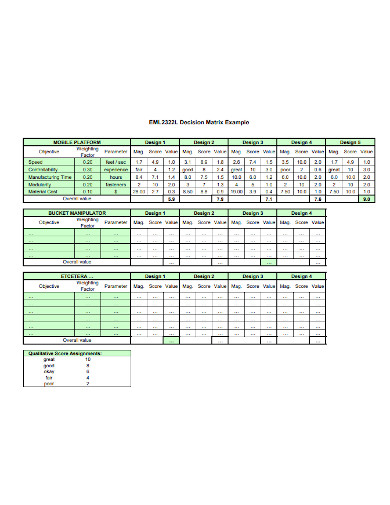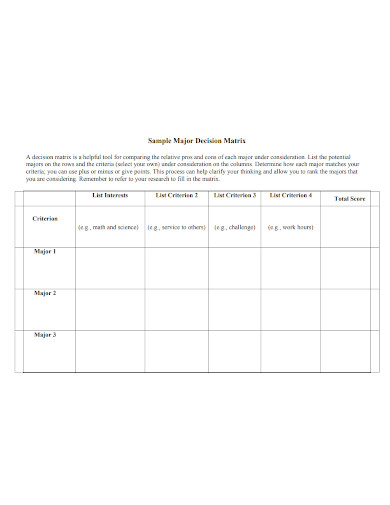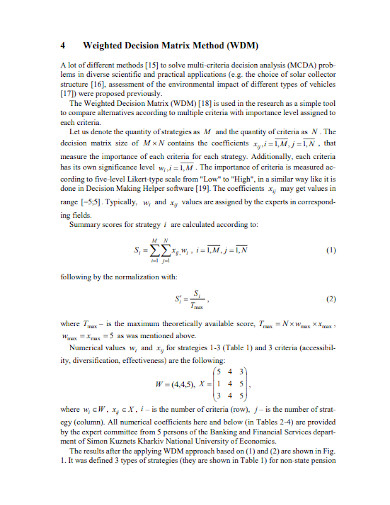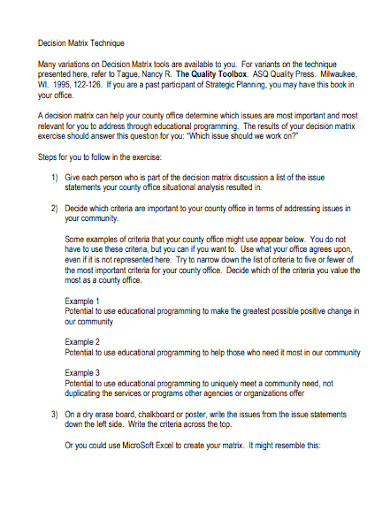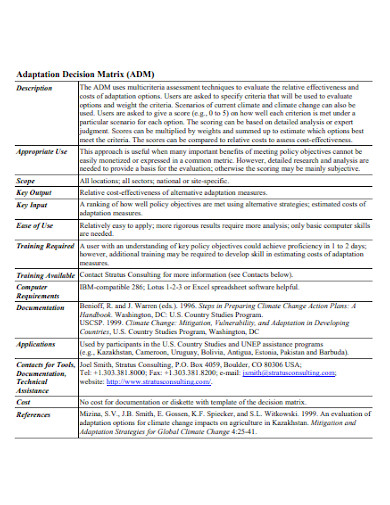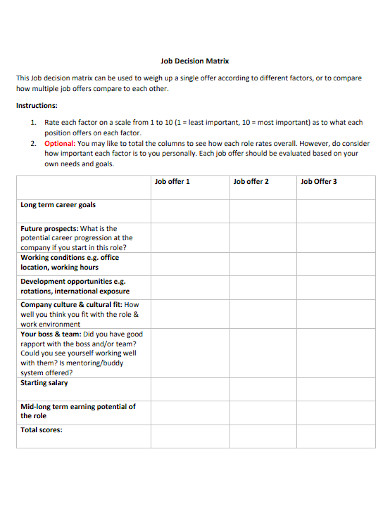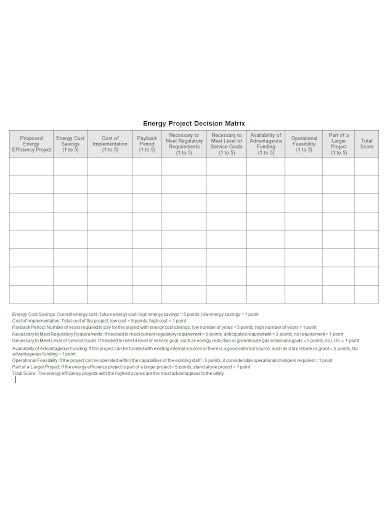Running a business has numerous problems and necessitates numerous vital decisions. Weighing the benefits and drawbacks might help you make such judgments. However, occasionally a more complete decision-making process, such as a decision matrix, is required. The choice matrix approach was developed by Stuart Pugh, a professor and head of design at the University of Strathclyde in Scotland, to aid in the selection of design solutions. The tool has since developed into an universal decision-making help, particularly in the corporate sphere. A decision matrix, also known as the Pugh method, grid analysis, or multi-attribute utility theory, lowers subjectivity to assist you in reaching a sound conclusion.
10+ Decision Matrix Samples
A decision matrix is a tool that assists business analysts and other stakeholders in more objectively evaluating their options. Decision-making grids explain the criteria for making a decision and order them based on the most significant elements. These grids give analysts with a quantitative approach for carefully examining their possibilities.
1. Decision Matrix Template
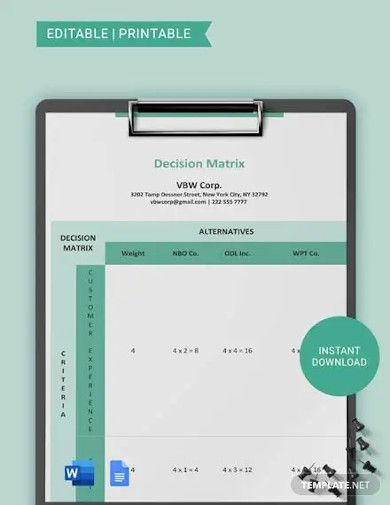
2. Criteria Decision Matrix Template

3. Decision Matrix Sample
4. Engineering Design Decision Matrix
5. Decision Matrix Example
6. Sample Major Decision Matrix
7. Weighted Decision Matrix Method
8. Decision Matrix Technique
9. Adaptation Decision Matrix
10. Job Decision Matrix
11. Energy Project Decision Matrix
When To Use Decision Matrix?
The decision matrix has the advantage of being adaptable to a wide range of situations. When you or your team are assessing several options or criterion that need to be whittled down to a single final pick, however, it is most effective. It’s a popular option among business analysts, project managers, business executives, designers, and other stakeholders who must juggle several possibilities with intricate criteria and specifications.
Making Decision Matrix
The simplicity with which the decision matrix can be created is its charm. A decision matrix can be hand made on a piece of paper, on a whiteboard, or in a spreadsheet. Printable template options are also accessible. The ready-to-use decision matrix template from Lucidchart can help you get started straight now. You can personalize your templates with innovative features like data linkage and conditional formatting to determine the most suitable solution faster.
When faced with various options and circumstances, a decision matrix can help to clarify the situation and emphasize factors that may impact the outcome. This quantitative strategy can help you guide your firm to success by removing emotion and uncertainty. A decision matrix, unlike a basic list of pros and disadvantages, allows you to assign a relative value to each component and weigh them accordingly.
A decision matrix, according to Amie Devero, managing partner of Amie Devero Coaching & Consulting, is a great tool for helping people identify more reasonable alternatives when they feel they are presented with a binary choice.
A decision matrix can assist you in not just making complex judgments, but also in prioritizing activities, solving problems, and constructing arguments to support a previous decision.
If you’re deciding between a few similar solutions based on numerous quantitative factors, it’s an excellent decision-making tool. There is a sweet spot for the number of variables each solution should contain, according to Steve Kurniawan, a content specialist and growth strategist at Nine Peaks Media.
FAQs
What are other alternative decision-making matrices?
SWOT analysis (strengths, weaknesses, opportunities, and threats) is a simple business tool for guiding decision-making based on internal and external considerations. To ensure the analysis is complete, it should be performed by deeply invested team members and conducted jointly with a team of employees who have varied perspectives on the organization.
What is a Pareto Analysis?
Leaders that want to determine which solutions will have the most impact when implemented can conduct a Pareto analysis, sometimes known as the “80/20 rule.” This analysis can not only identify difficulties, but it can also enhance efficiency by prioritizing significant issues, raise productivity, and even increase profitability.
If you want to see more samples and formats, check out some decision matrix samples and templates provided in the article for your reference.
Related Posts
FREE 7+ 30 60 90 Day Business Plan Samples in MS Word | Google Docs | Pages | PDF
Monograph
Key Log
Report Writing
Discharge Summary
Research Report
Sample Tender
Company Profile
Statement of Account
8+ Price Tag Samples in Illustrator | PSD | Publisher | Apple Pages
FREE 26+ Awesome Doctors Business Card Templates in AI | PSD | Publisher | MS Word | Pages
FREE 15+ Best Printable Envelope Templates in EPS
FREE 24+ Valentine’s Day Gifts for your Girlfriend
FREE 14+ Sample Valentine’s Day Crafts in PSD
FREE 10+ Sample Valentines Day Coupons in PSD

